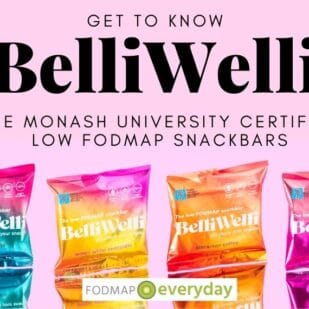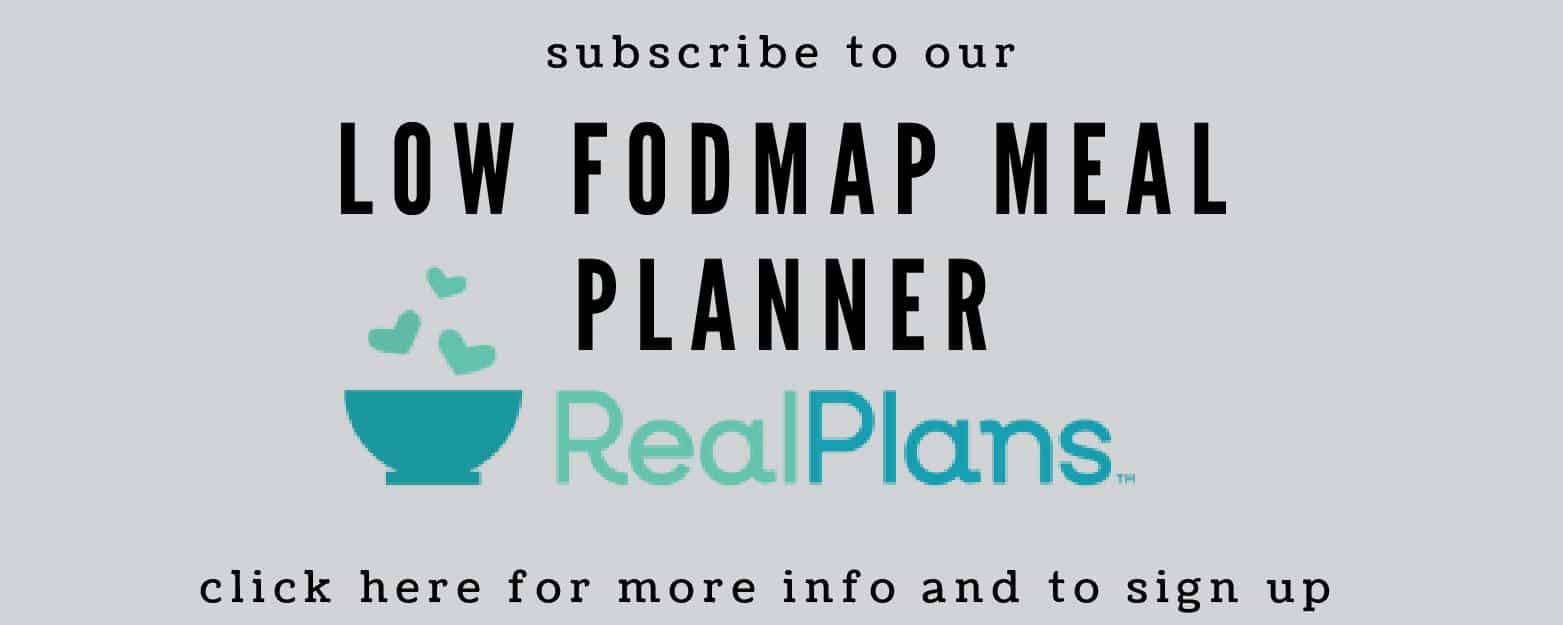Hopefully by now you know that we highly recommend that everyone following the low FODMAP diet have both the Monash University smartphone app and the FODMAP Friendly smartphone app. This is because these are the two entities doing the original research and lab testing; they are the primary resources for the diet.
But what do you do when their lab tests results for the same food – such as avocados, beets, strawberries, red bell peppers and many others – differ? Or, just as confusing, what if one the institutions, like Monash, re-tests a food and the results are different from prior tests?
Two Main Reasons Why Lab Test Results Differ
There are two main reasons why lab tests for FODMAP content differ:
- Monash University and FODMAP Friendly use slightly different FODMAP thresholds.
- FODMAP content is variable in food. Every lab test is expected to have different results.
This article will take you through it step-by-step.
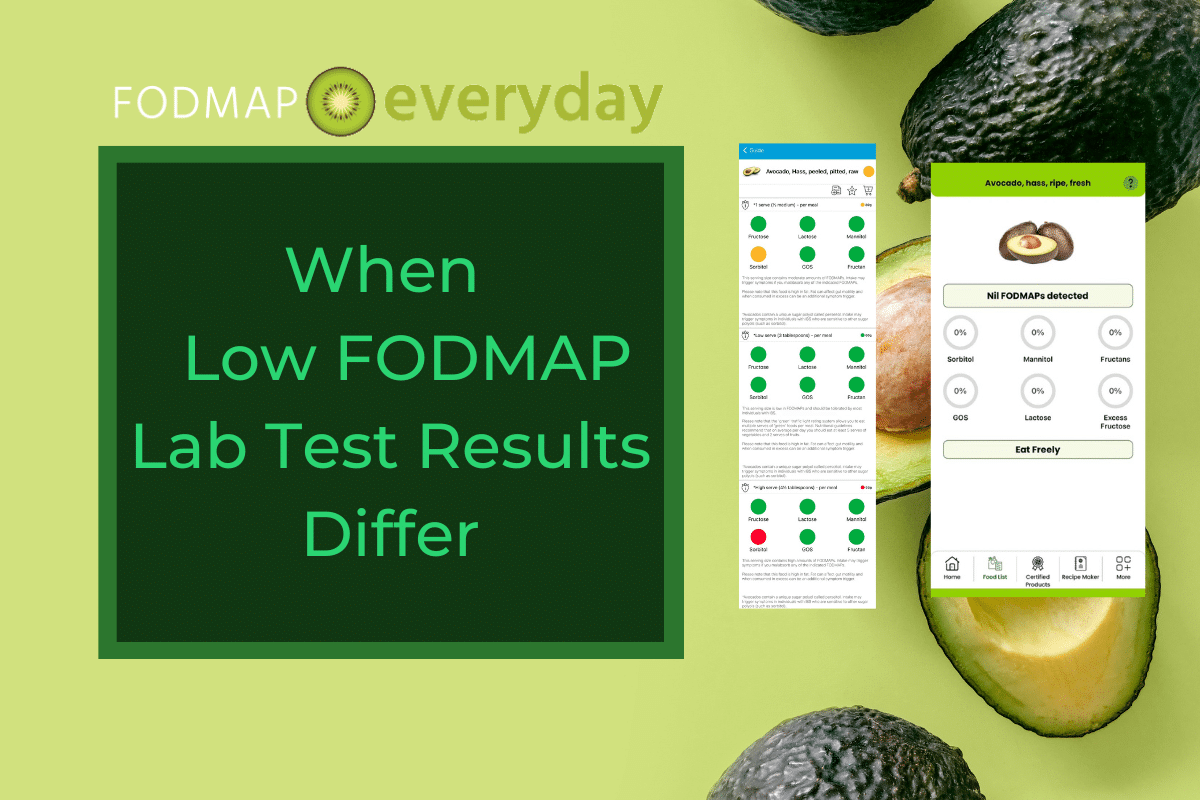
- Two Main Reasons Why Lab Test Results Differ
- FODMAP Thresholds
- FODMAP Content in Foods is Variable
- Foods Included In Our List of Conflicting Low FODMAP Lab Test Results
- Comparison Chart of Conflicting Low FODMAP Serving Sizes
- The Main Gist
- Frequently Asked Questions
- FODMAP Lab Testing Articles At A Glance
- The Takeaway
FODMAP Thresholds
One of the very first things to understand is that Monash University and FODMAP Friendly base their cut-offs for FODMAPs on slightly different values, in certain instances. This means that the serving size recommendations in their apps are values that have been determined to be amounts that will not trigger IBS symptoms in most people. Take a look below (you can read more in the individual articles on Monash and FODMAP Friendly):
The different thresholds partly explain why the app entries for the same foods in each app differ.
Oligosaccharide Threshold Comparisons
You can see below that Monash University divides Oligosaccharides into two group, while FODMAP Friendly does not.
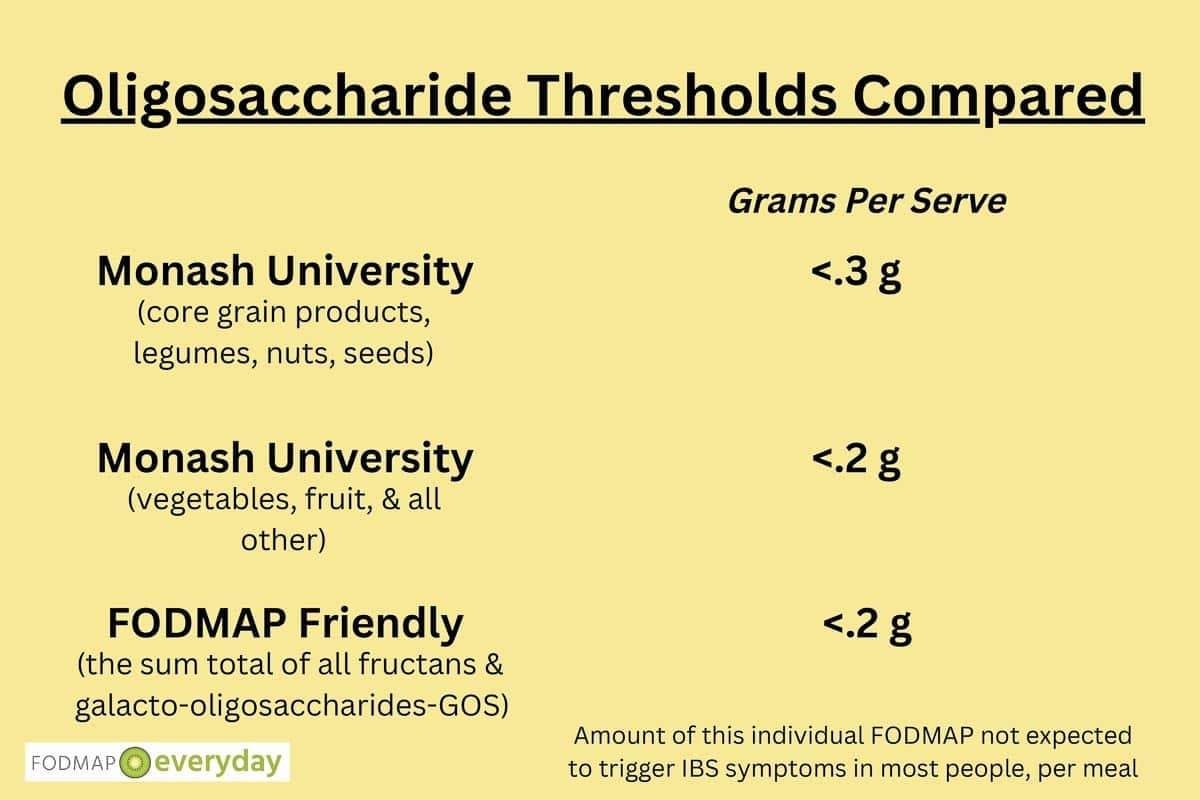
Polyol Threshold Comparisons
For Polyols as a group, and for the individual polyols – sorbitol and mannitol – all numbers are very similar, but they doing differ between Monash and FODMAP Friendly.
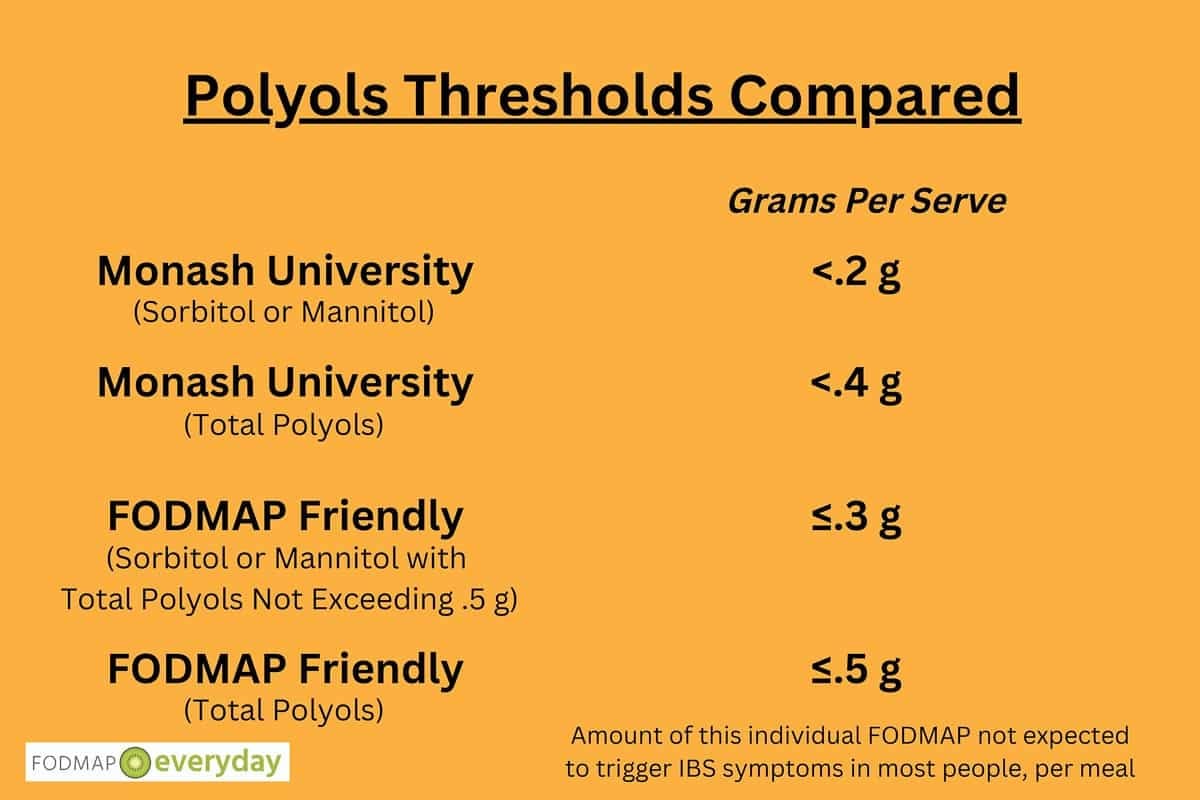
Excess Fructose Threshold Comparisons
Monash University divides the way it looks at fructose. The first entry applies to foods where fructose is greater than glucose, but other FODMAPs might also be present in that food, therefore the amount is lower.
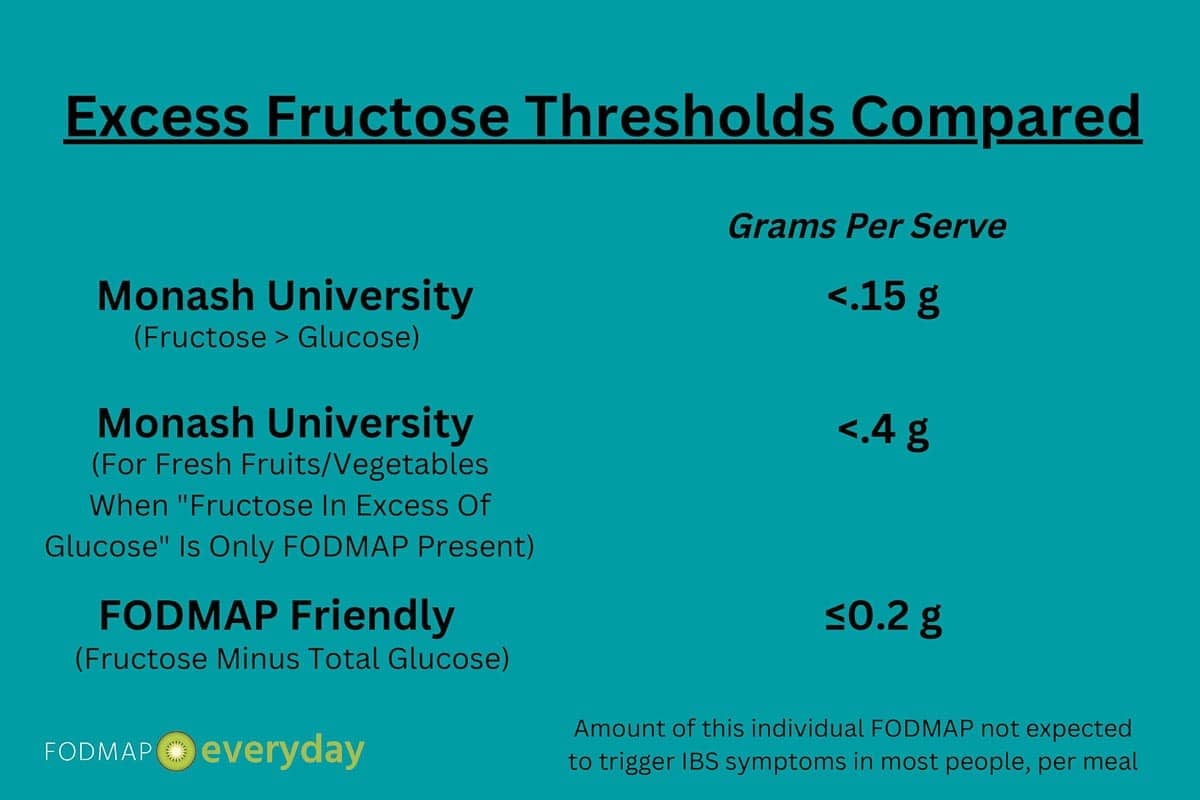
Lactose Threshold Comparisons
The thresholds for lactose are the most dissimilar.
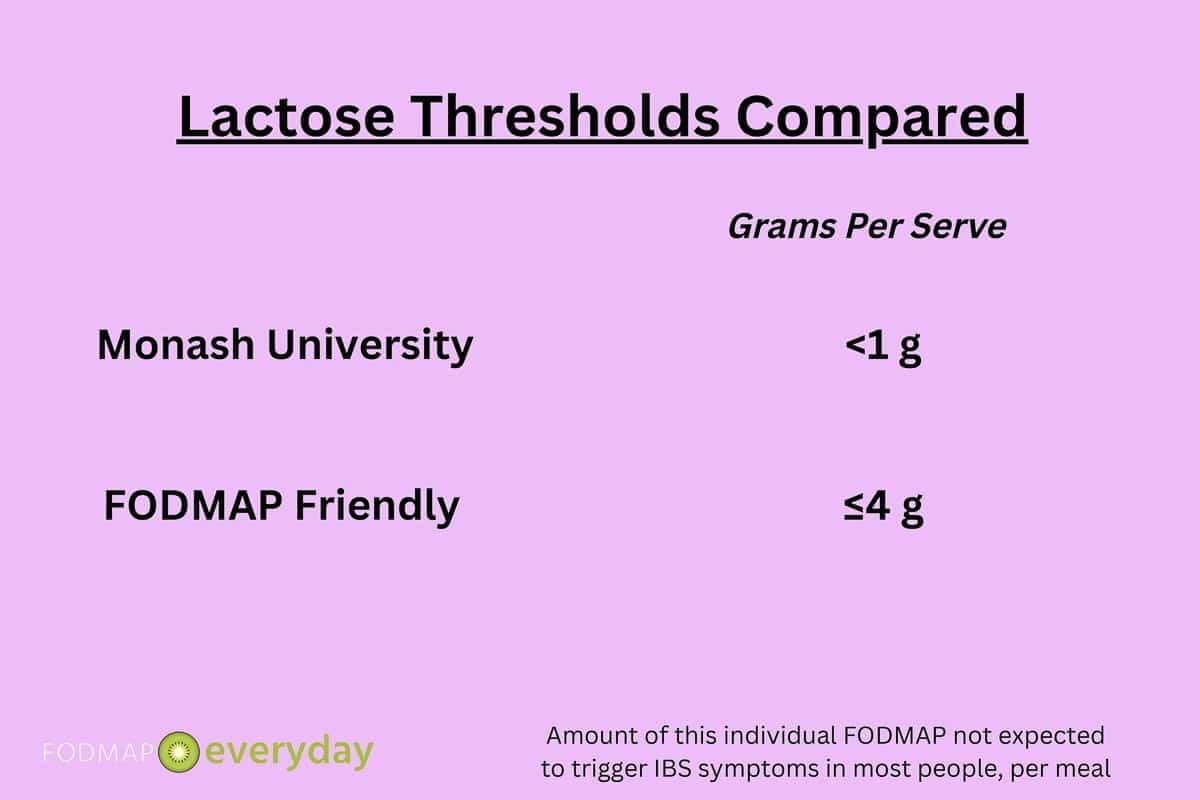
FODMAP Content in Foods is Variable
We have written an entire post for you, FODMAP Content In Food Is Variable; please read it now.
Here is a snapshot:
- There can be thousands of varieties of any given fruit or vegetable, and we typically do not know what variety is tested.
- Microclimates (temperature, soil, air, water) of farms vary hugely and can affect FODMAP content.
- Differences in agricultural methods, such as fertilizer use, ripeness upon harvesting, storage conditions and more can influence nutrients in crops.
- Research has demonstrated that plants can change their chemical structure when exposed to stressors in their environment.
- Cold storage, pests, disease, and environmental changes, for instance, can lead to the development of fructans where they did not exist before.
- Increases in fructose content are also known to occur in these environments.
Foods Included In Our List of Conflicting Low FODMAP Lab Test Results
This graph below not an exhaustive list. We have focused on very popular food fruits and vegetables that people following the low FODMAP diet want to know about, and in some cases that we know have had different lab results between the two testing bodies (Monash University and FODMAP Friendly). We have also included outliers that were just so extreme, we thought they deserved a mention – check out blackberries!
The reason why we have focused on fruits and vegetables is because they are the ones most likely to vary quite a bit in FODMAP content due to country of origin, ripeness, harvesting, handling and storage procedures, etc.
Please read our article, Understanding the Latest Monash University & FODMAP Friendly App Updates: What They Mean for You.
Comparison Chart of Conflicting Low FODMAP Serving Sizes
Here are some of the low FODMAP amounts reported by Monash University and FODMAP Friendly. The “Max Serve Size” (right column) that is still low FODMAP is a new feature from the FODMAP Friendly app (we love it). If a cell is empty, it is because there is no data available for a low FODMAP serving size.
Where we have data available from multiple testing times, we have included them in order. So, if it says, “No FODMAPs/Now 50 g”, it means initial lab tests showed “no FODMAPs”; subsequent tests showed 50 g to be the low FODMAP serving size. Both tests are accurate (again, read those articles linked above).
Note that the Monash University and FODMAP Friendly vertical columns show recommended serving size, which is not necessarily the maximum that you can eat and remain low FODMAP. Please review our article, What Is A Low FODMAP Serving Size?
Now, let’s look at some ingredients.
| Ingredient | Monash University | FODMAP Friendly | FODMAP Friendly Max Low FODMAP Serve Size |
|---|---|---|---|
| Avocado | was 30 g/now 60 g | 80 g | was 1000 g/then 80 g/then no FODMAPs detected |
| Apricot, fresh | was 16 g/now 15 g | 53 g | |
| Beet root, raw | 25 g | 75 g | 150 g |
| Black Grapes | 100 g | 1000 g | |
| Blackberry | 4 g | 150 g | was 375 g/now 250 g |
| Blueberry | was 40 g/now 125 g | 150 g | was 250 g/ now 300 g |
| Broccoli (heads) | 75 g | ||
| Broccoli (stalks) | was 45 g/ now 42 g | ||
| Broccoli (whole) | 75 g | was 750 g/ now 1500 g | |
| Brussels Sprouts | Was 38 g/then 50 g/now 53 g (raw) | 75 g (cooked) | 250 g (cooked) |
| Butternut Squash | was 45 g/ now 63 g (raw) | 75 g (cooked) | was 188 g/now 214 g (cooked) |
| Canned Peaches | 10 g | was 66 g/ now 67 g | |
| Canned Pumpkin | 75 g | 120 g | 150 g |
| Cherry Tomatoes | was 75 g/ now 45 g | 75 g | was 750 g/ now 1500 g |
| Common Ripe Banana | was 35 g/ now 37 g | 88 g | |
| Common Tomato (beefsteak) | was no FODMAP/now 65 g | 75 g | was 84 g/now 83 g |
| Cucumber | was No FODMAPs/now 75 g | was 64 g/now 0 g | was 1000 g/now 67 g |
| Dried Dates | was 8 g/now 30 g | 30 g | was 60 g/now 43 g |
| Dried Figs | 40 g | was 58 g/now 73 g | |
| Dried Pineapple | 20 g | 31 g | |
| Edamame | was 90 g/now 75 g | 168 g | was 259 g/now 258 g |
| Fresh Figs | 5 g | 64 g | 214 g |
| Grapefruit (image shows pink) | 80 g | 150 g | was 250 g/now 180 g |
| Green Beans (raw) | 75 g | 75 g | was 125 g/now 94 g |
| Green Bell Pepper (raw) | 75 g | 75 g | 750 g |
| Leek Bulb | 14 g | was 46 g/ now 47 g | |
| Leek Leaves | was 100 g/now 75 g | 37 g | was 83 g/now 82 g |
| Mango (raw) | 40 g | 54 g | |
| Nectarine (white) | 67 g | 150 g | then 215 g/now 250 g |
| Nectarine (yellow) | 18 g | 150 g | was 93 g/now 150 g |
| Onion (white) | 10 g | 15 g | |
| Pear | was 5 g/now 4 g | was 0 g | now 13 g |
| Raspberries | 60 g | was 45 g/now 0 g | was 82 g/now 39 g |
| Red Bell Pepper | No FODMAPs/Now 43 g | 75 g | 750 g |
| Red Grapes | No FODMAPs/Now 28 g/10 g | 150 g | was 750 g/then 900 g/now 750 g |
| Red Globe Grapes | No FODMAPs | ||
| Red Onion | 10 g | was 28 g/now 27 g | |
| Roma Tomato | was 75 g/now 48 g | 75 g | was 108 g/now 107 g |
| Scallion Bulb | 32 g | was 19 g/now 20 g | |
| Scallion Greens | was No FODMAPs/now 75 g | 16 g | was 161 g/now 160 g |
| Strawberry | No FODMAPs/Now 65 g | was 51 g/then 45 g/now 50 g | |
| Watermelon (seedless) | was 15 g/now 18 g | was 50 g/now 13 g | |
| Peach (white) | was 18 g/now 19 g | was 83 g/now 68 g | |
| Peach (yellow) | 30 g | was 100 g/now 38 g | |
| Yellow Bell Pepper | was 24 g/now 27 g | ||
| Yellow Summer Squash | 75 g | 100 g | 101 g |
| Zucchini (courgette) | was 65 g/now 67 g | 75 g | was 375 g/now 107 g |
The Main Gist
The over-arching concept that you have to understand is that both Monash University and FODMAP Friendly conduct valid and trustworthy lab tests. You can read much more in our articles, Monash University Lab Testing Explained and FODMAP Friendly Lab Testing Explained. They might report different results occasionally, but that does not mean one test was right and one was wrong. Or that one is “more” correct! Even when it is the same institution testing foods and then re-testing foods and getting different results. Both results are valid.
Both Monash University and FODMAP Friendly conduct valid and trustworthy lab tests.
As the above linked articles explain, it simply means that for the items tested at that time, those are the results that the lab tests revealed and – especially when it comes to fresh fruits and vegetables – the produce you eat will then again be different from what they tested.
It is literally impossible for the food that you buy today, next week, or next month to be the same as what was lab tested. This is why the app entries are guides.
You Are Not A Lab

Always look at lab tests as lines in the sand from which to begin your exploration of FODMAPs; use the lab information to help guide what your unique relationship is to FODMAPs, which might be very different from what the labs report. You might be able to eat more, or less. As we are fond of saying, you are not a lab.
It is literally impossible for the food that you buy today, next week, or next month to be the same as what was lab tested. This is why the app entries are guides.
Frequently Asked Questions
Which lab test you use as your starter marker is up to you. They are all accurate. We know some Facebook groups and some RDs only use Monash and caution folks away from FODMAP Friendly. I have never heard one convincing argument as to why. If you read the articles linked above, you can certainly draw your own conclusions.
To those who say it makes things more confusing, here is my take: your patients, or you yourself, will find conflicting information online and elsewhere. If you do not know the sources of the differences of opinion, or how they came to those conclusions, you truly cannot make a judgement or a decision.
Once you do know that all the labs used are reputable, that lab results will vary regardless due to variety of produce, ripeness, handling, storage and country of origin, then you begin to understand that all these results are just what were detected in a snapshot in time.
You might be asking yourself, of Monash University and FODMAP Friendly, which is more conservative? Or, perhaps you want to know who is more lenient with their serving size recommendations?
Each of the testing bodies have examples of reporting more stringent recommendations, more generous ones, and they are sometimes in agreement. There is no black and white answer.
FODMAP Lab Testing Articles At A Glance
Here are all of our other articles that pertain to lab testing for FODMAPs. We suggest that you read them all:
- Monash University Lab Testing Explained
- FODMAP Friendly Lab Testing Explained
- How To Use The Monash University Smartphone App
- How To Use The FODMAP Friendly Smartphone App
- FODMAP Content in Food Is Variable
- Understanding the Latest Monash University & FODMAP Friendly App Updates: What They Mean for You
The Takeaway
Both Monash University and FODMAP Friendly lab test foods for FODMAP content and provide reliable results – even when they report different findings from test to test (of the same food) and from one another as lab testing bodies. It is to be expected that FODMAP content in foods, especially fruits and vegetables, will vary.
You can use any of the lab tested findings, new or older, from either Monash University or FODMAP Friendly as a baseline from which to begin to explore your relationship with FODMAPs, which will be unique.
You can use any of the lab tested findings, new or older, from either Monash University or FODMAP Friendly as a baseline from which to begin to explore your relationship with FODMAPs, which will be unique.
Also, what you do or do not tolerate today will most likely be different a few months or a year from now. Your digestive tract is not static, and neither are your FODMAP reactions. This is why it is important to re-introduce foods periodically if you have breakthrough IBS symptoms or are wondering if you can tolerate something now that you couldn’t before.
Please make sure to read our articles on Monash University Lab Testing Explained, and also FODMAP Friendly Lab Testing Explained.
Rely on primary resources like Monash University and FODMAP Friendly to help guide your three phases of the low FODMAP diet.
